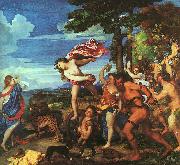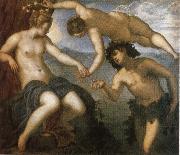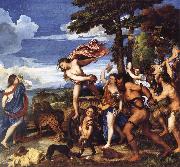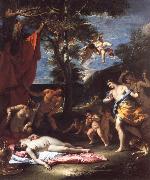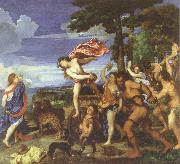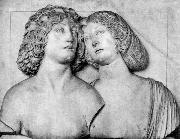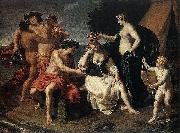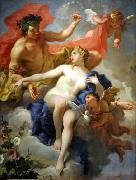Wholesale Oil Painting No Minimum |
|||||||||||
|
|
|||||||||||

|
|||||||||||
|
|
|
||||||||
|
|
||||||||
Bacchus and Ariadne
Bacchus and Ariadne Painting ID:: 1676 |
1523-24
National Gallery, London 1523-24 National Gallery, London |
|||||||
|
|
||||||||
Jacopo Tintoretto1518-1594 Italian painter. His father was a silk dyer (tintore); hence the nickname Tintoretto ("Little Dyer"). His early influences include Michelangelo and Titian. In Christ and the Adulteress (c. 1545) figures are set in vast spaces in fanciful perspectives, in distinctly Mannerist style. In 1548 he became the centre of attention of artists and literary men in Venice with his St. Mark Freeing the Slave, so rich in structural elements of post-Michelangelo Roman art that it is surprising to learn that he had never visited Rome. By 1555 he was a famous and sought-after painter, with a style marked by quickness of execution, great vivacity of colour, a predilection for variegated perspective, and a dynamic conception of space. In his most important undertaking, the decoration of Venice's Scuola Grande di San Rocco (1564 ?C 88), he exhibited his passionate style and profound religious faith. His technique and vision were wholly personal and constantly evolving. |
||||||||
|
|
||||||||
|
|
Bacchus and Ariadne
Bacchus and Ariadne Painting ID:: 30515 |
mk68
Oil on canvas
4' 9 1/2x5' 3 3/4"
Venice,
1576
Italy
mk68 Oil on canvas 4' 9 1/2x5' 3 3/4" Venice, 1576 Italy |
||||||
|
|
||||||||
TitianItalian High Renaissance Painter, ca.1485-1576 Italian painter active in Venice. As a young man he was taught by the Bellini family and worked closely with Giorgione. His early works are so similar in style to Giorgione's as to be indistinguishable, but soon after Giorgione's early death Titian established himself as the leading painter of the Republic of Venice. Among his most important religious paintings is the revolutionary and monumental Assumption (1516 ?C 18) for Santa Maria dei Frari, in which the Virgin ascends to heaven in a blaze of colour accompanied by a semicircle of angels. Titian was also interested in mythological themes, and his many depictions of Venus display his work's sheer beauty and inherent eroticism. Bacchus and Ariadne (1520 ?C 23), with its pagan abandon, is one of the greatest works of Renaissance art. Titian was sought after for his psychologically penetrating portraits, which include portrayals of leading Italian aristocrats, religious figures, and Emperor Charles V. He reached the height of his powers in The Rape of Europa (c. 1559 ?C 62), one of several paintings done for Philip II of Spain. He was recognized as supremely gifted in his lifetime, and his reputation has never declined. |
||||||||
|
|
||||||||
|
|
Bacchus and Ariadne
Bacchus and Ariadne Painting ID:: 43040 |
mk170
1522-1523
Oil on canvas
172.2x188.3cm
mk170 1522-1523 Oil on canvas 172.2x188.3cm |
||||||
|
|
||||||||
RICCI, SebastianoItalian painter, Venetian school (b. 1659, Belluno, d. 1734, Venezia).Painter and draughtsman. He painted light and colourful religious, historical and mythological subjects with a fluid, painterly touch. His rediscovery of Paolo Veronese, whose settings and costumes he borrowed, was important to later Venetian painters. Sebastiano was an itinerant artist, celebrated throughout Europe. |
||||||||
|
|
||||||||
|
|
Bacchus and Ariadne
Bacchus and Ariadne Painting ID:: 43268 |
mk170
1700-1710
Oil on canvas
75.9x63.2cm
mk170 1700-1710 Oil on canvas 75.9x63.2cm |
||||||
|
|
||||||||
TitianItalian High Renaissance Painter, ca.1485-1576 Italian painter active in Venice. As a young man he was taught by the Bellini family and worked closely with Giorgione. His early works are so similar in style to Giorgione's as to be indistinguishable, but soon after Giorgione's early death Titian established himself as the leading painter of the Republic of Venice. Among his most important religious paintings is the revolutionary and monumental Assumption (1516 ?C 18) for Santa Maria dei Frari, in which the Virgin ascends to heaven in a blaze of colour accompanied by a semicircle of angels. Titian was also interested in mythological themes, and his many depictions of Venus display his work's sheer beauty and inherent eroticism. Bacchus and Ariadne (1520 ?C 23), with its pagan abandon, is one of the greatest works of Renaissance art. Titian was sought after for his psychologically penetrating portraits, which include portrayals of leading Italian aristocrats, religious figures, and Emperor Charles V. He reached the height of his powers in The Rape of Europa (c. 1559 ?C 62), one of several paintings done for Philip II of Spain. He was recognized as supremely gifted in his lifetime, and his reputation has never declined. |
||||||||
|
|
||||||||
|
|
bacchus and ariadne
bacchus and ariadne Painting ID:: 56008 |
mk247
1520 to 23 ,oil on canvas,69.5x75.25 in,176.5x191 cm,national,gallery,london,uk mk247 1520 to 23 ,oil on canvas,69.5x75.25 in,176.5x191 cm,national,gallery,london,uk |
||||||
|
|
||||||||
|
|
||||||||
|
|
Bacchus and Ariadne
Bacchus and Ariadne Painting ID:: 63552 |
1520-25 Marble, height: 56 cm Kunsthistorisches Museum, Vienna In Venice, during the closing decades of the 15th century, a pure classicising style, derived from Andrea Mantegna, was introduced. Tullio Lombardo turned to classical sculpture proper for his guiding force. His portraits of young couples in high relief (the other is in the Ca' d'Oro in Venice) were inspired by antique funerary busts, but the sculptor completely rejected naturalism. The simplicity of the volumes and the sobriety of expression are set off by decorative refinements which depart from the antique schema. They include embroidered hairnets in the hair and meticulously designed sinuous locks. His Bacchus and Ariadne shows him at his most lyrical, under the influence of the Humanism at the Gonzaga court at Mantua, where he worked for Isabella d'Este in 1523 and 1527 1520-25 Marble, height: 56 cm Kunsthistorisches Museum, Vienna In Venice, during the closing decades of the 15th century, a pure classicising style, derived from Andrea Mantegna, was introduced. Tullio Lombardo turned to classical sculpture proper for his guiding force. His portraits of young couples in high relief (the other is in the Ca' d'Oro in Venice) were inspired by antique funerary busts, but the sculptor completely rejected naturalism. The simplicity of the volumes and the sobriety of expression are set off by decorative refinements which depart from the antique schema. They include embroidered hairnets in the hair and meticulously designed sinuous locks. His Bacchus and Ariadne shows him at his most lyrical, under the influence of the Humanism at the Gonzaga court at Mantua, where he worked for Isabella d'Este in 1523 and 1527 |
||||||
|
|
||||||||
Alessandro Turchi(1578 - 22 January 1649) was an Italian painter of the early Baroque, born and active mainly in Verona, and moving late in life to Rome. He also went by the name Alessandro Veronese or the nickname L'Obetto. Turchi initially trained with Felice Riccio (il Brusasorci) in Verona. By 1603, he is already working as independent painter, and in 1606-1609, Turchi paints the organ shutters for the Filarmonica Academy of Verona. When Brusasorci dies in 1605, Turchi and his fellow Paschal Ottino (or Pasquale) complete a series of their deceased master's canvases. In 1610, he completes an Assumption altarpiece for the church of San Luca of Verona In 1612, the Veronese Guild of the Goldsmiths commissions an altarpiece, today lost, of the Madonna and Saints. On leaving the school of Riccio, he went to Venice, where he worked for a time under Curio Cagliari. |
||||||||
|
|
||||||||
|
|
Bacchus and Ariadne
Bacchus and Ariadne Painting ID:: 87921 |
Oil on canvas, 114,5 x 147,5 cm
cjr Oil on canvas, 114,5 x 147,5 cm cjr |
||||||
|
|
||||||||
Giambattista Pittoni(1687?C1767) was an Italian painter of the late-Baroque or Rococo period, active mainly in his native Venice. Pittoni is best known for his "grand-manner" canvases depicting religious, historical, and mythological subjects (such as Sophonisba and Polyxena). He was a co-founder of the official painter's academy in Venice (in competition to the old fraglia or painter's guild), the Accademia di Belle Arti di Venezia, and he succeeded as President (1758?C1761) his contemporary Giovanni Battista Tiepolo. Pittoni never left his native Venice, but completed commissions from German, Polish, Russian, and Austrian patrons. His mature palette was noted, as was Tiepolo's, for his lightness of tone. Besides Tiepolo, Pittoni's influences were Giovanni Battista Piazzetta, Sebastiano Ricci, and Antonio Balestra. His paintings were of a Rococo style, but later became more sedate in their approach towards Neoclassicism. |
||||||||
|
|
||||||||
|
|
Bacchus and Ariadne
Bacchus and Ariadne Painting ID:: 97275 |
1720s
Medium oil on canvas
Dimensions 171 X 130 cm
cyf 1720s Medium oil on canvas Dimensions 171 X 130 cm cyf |
||||||
|
|
||||||||
|
Giambattista Pittoni (1687?C1767) was an Italian painter of the late-Baroque or Rococo period, active mainly in his native Venice. Pittoni is best known for his "grand-manner" canvases depicting religious, historical, and mythological subjects (such as Sophonisba and Polyxena). He was a co-founder of the official painter's academy in Venice (in competition to the old fraglia or painter's guild), the Accademia di Belle Arti di Venezia, and he succeeded as President (1758?C1761) his contemporary Giovanni Battista Tiepolo. Pittoni never left his native Venice, but completed commissions from German, Polish, Russian, and Austrian patrons. His mature palette was noted, as was Tiepolo's, for his lightness of tone. Besides Tiepolo, Pittoni's influences were Giovanni Battista Piazzetta, Sebastiano Ricci, and Antonio Balestra. His paintings were of a Rococo style, but later became more sedate in their approach towards Neoclassicism. Bacchus and Ariadne 1720s Medium oil on canvas Dimensions 171 X 130 cm cyf |
||||||||
|
|
||||||||
|
Prev Next
|
||||||||
|
|
||||||||
|
Related Paintings to Giambattista Pittoni :. |
||||||||
|
|
||||||||
|
CONTACT US |
